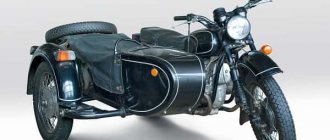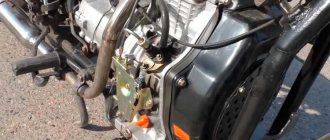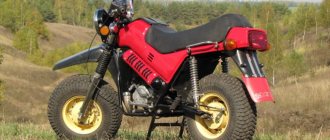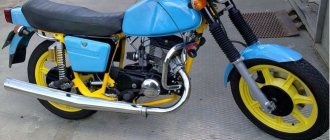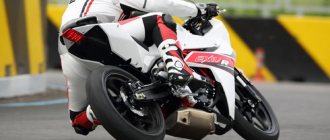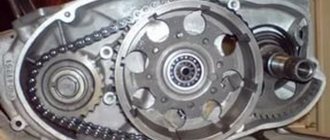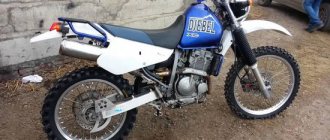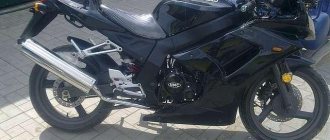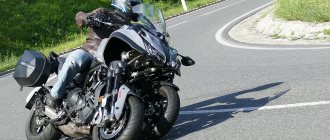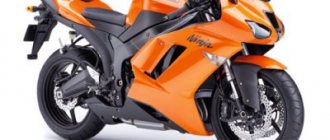The domestic motorcycle “Dnepr” MT 10-36 belongs to the class of heavy two-wheeled equipment. The unit is operated mainly with a stroller. The purpose of the motorcycle is to transport a driver with two passengers or cargo weighing no more than 250 kg. The car moves well on asphalt and dirt roads. The gearbox is equipped with a reverse function. Let's look at the characteristics and features of this technology.
Description
Externally, the Dnepr MT 10-36 differs from its predecessors in levers with ball ends, union nuts on the exhaust pipes, and a folding passenger footrest. In 1976, the manufacturer (motorcycle plant in Kyiv) improved the MT 10 series motorcycle. As a result, the power of the power unit increased to 36 “horses”, and some components in the carriage structure were also transformed.
This model received the designation “Dnepr” MT 10-36. The main modernization work is focused on GOST standards in terms of increasing safety and reducing external noise. The main device that guarantees the safety of movement is the brake unit, which has undergone a radical redesign on the front wheel. Now there are a pair of pads, each of which is activated by an individual cam, drive and driven levers.
Decline of Dnepr motorcycle production
In the 80s and 90s, the plant produced only a few new models, the most common being the MT-16. This is the first civilian heavy motorcycle with an overhead valve engine and a sidecar wheel drive. In fact, all subsequent models underwent spot changes: a new ignition switch, an upgraded dry filter and an improved carburetor. In 1992, the last Dnepr motorcycle from the Chopper series was released. In 2000, the plant’s management attempted to revive production, and even developed a special modification “Dnepr” for export. But the project was quickly abandoned, without establishing mass production of the new heavy motorcycle (about 30 copies were produced in total). Thus, the legendary Dnepr has gone down in history forever, because the chances of reviving production are virtually zero. The plant was converted into a business center, and all equipment was handed over to a scrap metal collection point.
Peculiarities
On the Dnepr MT 10-36, the gaps between the locking pads and the brake drum are adjusted as wear occurs. The process is carried out by tensioning the cable using a fitting and then turning the cams on the axis. This is the first time this design has been used on heavy bikes. The advantage of such a brake is the possibility of installation on any of the previous versions of the motorcycle. Also, this type of front brake can act as a parking brake. To do this, you just need to press the brake lever on the steering wheel and secure it with a special push-button latch.
The brake element and clutch levers end in spherical knobs with a diameter of 2 cm. They serve to prevent possible injuries. The front mudguard is flanged at the end, and the passenger footrests tilt up and back at an angle of 45 degrees. A lock that locks the steering wheel in the column acts as an anti-theft device.
Safety
MT 10-36 "Dnepr" is safer in terms of fire-fighting equipment. This became possible thanks to the presence of clamps on gasoline hoses. They prevent pipelines from jumping off and causing sparks. To reduce noise, a new atmospheric filter element and a more efficient muffler are used. This element is also interchangeable with analogues of other models. Only in this case it is necessary to install a new jet (180 cc/min instead of 200 cc/min). This design significantly reduces the noise of exhaust gases and prevents fuel from getting on hot parts.
The outer diameter of the muffler increased to 86 mm, and the volume increased by 1.6 times. The exhaust pipes and the internal configuration of the element have been transformed. The pipes on the cylinder are now secured with union nuts rather than clamps. This provides a tighter connection and helps remove a significant portion of the heat. After these improvements, the noise level of the unit decreased by 10 dB.
Engine disadvantages
The Dnepr engine, unlike the Ural engine, has several critical disadvantages:
- The absence of an oil filter in the engine does not ensure cleaning of the oil in the lubrication system;
- Air cooled. Often, such cooling may not be enough to ensure the desired temperature, especially in off-road conditions.
- Prone to overheating. Requires constant monitoring of the oil level, which it likes to consume or “spit out” into the breather;
- In terms of design solutions, the Dnepr engine has a number of shortcomings. The bottom line is that, for unknown reasons, there is no oil filter in the engine; instead there is a so-called centrifuge (centrifugal filter). When centrifugal oil filters are used in car engines, they are installed after coarse oil filters, where they act as fine filters. To put it briefly and clearly, this is a round-shaped part that stands in the engine, it rotates and oil gets into it, there, according to the engineers’ idea and the laws of physics, all the dirt, by inertia, should remain on the walls of this centrifuge and filtered clean oil should be supplied further to the oil system . In practice, some dirt still gets into the lubrication system, shortening the life of the engine. Since the oil channels become clogged, in particular in the crankshaft itself, preventing oil from reaching the crankshaft liners and all this is fraught with critical breakdowns. The Dnepr’s oil system needs improvement, which is what motorcycle owners do on their own, otherwise you’ll just end up with crankshaft liners turning. Therefore, it is recommended to change the engine oil more often;
- Also, according to owners, there are manufacturing defects in the form of a gap between the front engine cover and the crankshaft. This defect leads to the removal of most of the oil into the sump; accordingly, less of it reaches the crankshaft liners;
- The gearbox does not offer excellent smoothness and precision of gear changes. You need to change gears very carefully, otherwise you can simply switch from one speed to another without noticing;
- One cannot fail to note such an important drawback in our time as the relatively high fuel consumption. If you don’t improve the power supply system, it will cost you money, because in the days of the USSR, when fuel really cost a penny, little things like gasoline consumption bothered few people;
- Requires frequent maintenance. Dnepr motorcycle engines require more frequent maintenance compared to car engines. List of work that must be performed during engine maintenance: checking and adjusting valves (thermal clearances), replacing engine oil and oil filter, monitoring the condition of spark plugs;
- Difficulty in maintenance and rather low reliability of the entire system will be the main disadvantages of this engine;
- The pressure reducing valve installed in the pump is located in the crankcase above the oil level; filling it with oil itself is not possible in case of clogging, because the valve does not fit tightly to the seat. Valve cleaning is time-consuming because it also involves disassembling the engine;
- Moreover, it has relatively small output figures: 26 and 32 horsepower, depending on the internal combustion engine model;
- In addition, the engine often suffers from the pins being too tightly seated in the piston, which leads to overheating of the cylinders and heads.
Conclusion. Currently, the plant has stopped producing motorcycles, which has resulted in some shortage of spare parts. This was due to a banal economic recession. The internal combustion engine of the Dnepr motorcycle, the technical characteristics of which can successfully compete with the next generation of motorcycles, is subject to rapid wear and tear and, at the same time, frequent repairs. Reliability rating: “satisfactory.”
PS Dear motorcyclists! Through the comment submission form, you can leave feedback on the weak points and shortcomings of DNEPR motorcycle engines or on troubleshooting, maintenance and repair.
Other parameters
Updated spare parts for MT 10-36 "Dnepr" are noted in the following list:
- A battery ignition system is provided.
- The dry clutch assembly is equipped with two discs.
- The stroller is equipped with a lever suspension with spring-type hydraulic shock absorbers.
- On the front of the motorcycle there is a telescopic fork with hydraulics and springs.
- The rear wheel is equipped with a pendulum suspension with hydraulic spring shock-absorbing elements.
- Tire sizes – 3.75/19.
A significant design innovation was the absence of the need to change the oil. It is simply topped up regularly, lubricating the internal components of the power unit and the elements associated with it. This enhances the protection of key parts from corrosion and wear.
Motorcycle modifications
- M 72 (1950-1952). The very first model produced by the Kyiv Motor Plant. Structurally, it was an almost exact copy of the BMW R71.
- M 72N (1953-1957). Reinforced frame and wheels, new linkage fork, slightly modified engine and many minor changes.
- K-750 (1958-1962). An updated 26-horsepower engine, hydraulic shock absorbers, new sidecar suspensions and reduced fuel consumption.
- K-750M (1963-1967). An upgraded version of the previous generation.
- K-650, aka MT 8 (1968-1970). A new overhead valve 650 cc engine with a power of 27 horses, allowing speeds of up to 100 km/h.
- MT 9 (1971-1974). It was practically no different from the previous model, except that it was with this generation that the installation of turn signals began.
- MT 10 (1974-1976). One of the most popular and widespread modifications. The 6-volt electronics have been replaced with 12-volt ones.
- MT 10 36 (1976-1978). It is a slightly modified version of MT10. The engine has increased in power - it has as much as 32 horsepower instead of 27.
- MT 12 (1978-1984). The first civilian version of the bike with a low-valve 750 cc engine.
- MT 11 (1984-1986). The appearance of a hand (parking) brake, as well as the stroller’s own braking system.
- MT 16 (1986-1991). Civil version with overhead valve 650 cc engine.
- KMZ 8.157.01 Solo (1991). The very first single motorcycle in the line, not initially equipped with a side trailer.
- KMZ 8.157.02 (1991). Improved speedometer, 9th axle, modified suspensions and other little things.
- KMZ 8.157.022 Chopper (1992). The latest model, released in a small edition. It differs from the previous modification mainly in its body kit. It is practically never found on sale due to its rarity.
There were other modifications that were of no interest other than purely historical, since they were either produced in small batches for sports teams, or were used as special equipment, and were not available for free sale.
Electrical equipment
Below is the electrical diagram of the Dnepr MT 10-36. Features of the motorcycle's electrical equipment include the use of high-tech wires with the function of self-oxidation and self-shorting. They have low conductivity and are equipped with self-destructive insulation. This allows you to compare the spark advance with the clock frequency of the crankshaft. As a result, some devices were excluded from the scheme as they were unnecessary.
Why did Dnepr quickly sell out?
If we take into account the design of the Dnepr motorcycle, then, for example, against the background of one of the main competitors - Ural - the equipment had several obvious advantages. First of all, this is a repairable crankshaft. The crankshaft was one-piece, with plain bearings on the lower heads of the connecting rods (the connecting rods were collapsible).
This production technology made it possible to experience several obvious advantages of the motorcycle:
- the possibility of repairing the connecting rod and piston group;
- possibility of restoring the crankshaft;
- increased service life of the liners due to their increased contact area with the shaft.
But this also has some disadvantages, for example, if the lubricant supply is stopped, the liners quickly “die”. There is still no clear answer to the question of which engine is more durable - the Ural or the Dnepr. With regard to the gearbox, the situation is somewhat different. The gearbox on the MT-804 model was particularly reliable and durable. This gearbox has clear and smooth gear shifts. Another advantage for which many motorcyclists chose the Dnepr is its high-torque performance. The brutal appearance also played a significant role in the popularity of the motorcycle. The “classic” double seat also found its admirers.
Technical characteristics of "Dnepr" MT 10-36
Below are the main technical indicators for the motorcycle in question:
- Height/width/length – 1.08/1.62/2.43 m.
- Weight - 335 kg.
- Maximum load – 260 kg.
- Fuel tank capacity – 19 liters.
- The power unit is a four-stroke engine with a pair of cylinders and atmospheric cooling.
- Working volume – 650 cubic meters. cm.
- Startup type: kickstarter.
- The speed limit is 105 km/h.
- Fuel consumption – 8 l/100 km.
- Power – 32 horsepower at 5800 rpm.
- Brake type: pads.
- Piston diameter/stroke – 68/78 mm.
- Ground clearance – 12.5 cm.
- Track – 1.14 m.
- Wheelbase – 1.5 m.
Content
Currently, the production of motorcycles has been completely stopped, the plant is being repurposed into a business center, the equipment is being cut and sold for scrap.
Often, many people confuse KMZ Dnepr motorcycle models with IMZ Ural models due to the visual similarity of the designs.
Dnepr is a heavy road motorcycle with a sidecar, produced by KMZ - Kyiv Motorcycle Plant.
Nowadays, all heavy KMZ motorcycles are collectively called “Dnepr”, although the first model to receive its own “Dnepr” K-650 appeared in 1968.
The history of the creation of Dnepr motorcycles has passed a difficult path. After the end of the Great Patriotic War, the country experienced widespread devastation in all spheres of life. Nevertheless, it was necessary to somehow normalize not only the everyday life of citizens, but also the restoration of various production.
The Kiev Motorcycle Plant was one of the first enterprises where normal production was established, with very good prospects for development. It is clear that the first stages of development were very difficult, but the more valuable are the achievements that were shown by the plant’s employees from the very beginning of work and over the years.
Starting from the first stages of its activity, all employees of the Kyiv Motorcycle Plant were busy studying various technical data that could be useful in the production of the first motorcycle in the history of the enterprise - Kievlyanin. The plant itself was formed, thanks to decrees of the Council of People's Commissars No. 2435 - 652 of September 1945, on the basis of the Armored Repair Plant No. 8 on the street. Kagatnaya (currently Khokhlov Family Street). Initially, this model was produced at another plant, but since 1947, all main types of work on the design and manufacture of this motorcycle were carried out at the Kiev Motorcycle Plant.
The year 1947 was notable for the fact that at the Dnepr motorcycle plant they began to develop a new motorcycle on three wheels, simultaneously expanding production workshops aimed at improving the motorcycle industry. In 1949, about a hundred workers and specialists who had previously worked at another production enterprise came to the plant, which was a good help for the implementation of further plans for the manufacture and sale of the M-72 motorcycle. This model had a 4-stroke engine with two cylinders, a power of approximately 22 hp, a volume of 750 cm3 and a speed of 85 km/h. The M-72 was very popular, the rate of its production increased every year, which led to the idea of designing a new type of motorcycle - the M-53. The designer Pozdnyakov K.A. took on the implementation of this task. In addition, work continued to improve existing technologies, develop new seats and improve the braking system.
Since 1953, the Dnepr motorcycle plant finally came under the control of the Ministry of Mechanical Engineering. In 1956, more modernized motorcycles of previous models began to be produced - K-750SM and M-53S. They were produced in fairly wide quantities, at least fifty thousand copies per year, which continued until 1970. In addition, these models participated in various competitions in the GDR, bringing their country several gold models and a team first place. Compared to previous models, power has been increased to 26 hp, while fuel consumption has been reduced.
Another achievement of the Kyiv Motorcycle Plant was the K-750M model with a power of 27 hp. The main features of the new motorcycle are a more powerful generator and improved relay control technology. In addition, additional innovations were provided to make the driving process easier for the driver. In particular, the motorcycle was equipped with a distant view mirror and mudguards for the driver.
In 1967, the plant produced the first batch of the Dnepr motorcycle. It was equipped with a two-cylinder engine with a volume of 650 cm3. In addition, the Dnepr motorcycle could reach a speed of 100 km/h with an engine power of 32 hp. The Dnepr motorcycle engine was of the overhead valve type, at 5000 rpm. In connection with the large production of these motorcycles, which reached 25-26 thousand copies per year, a decision was made to further expand the factory buildings and re-equip them, aimed at the production and production of Dnepr motorcycles. This reconstruction made it possible to maintain the production rates that were necessary for the full sale of these motorcycles.
The year 1971 was notable for the fact that the Kiev plant produced the 500,000th copy of the Dnepr “MT-9” model. Just three years later, it was decided to produce another, more modern model of the Dnepr - “MT-10”. The main difference from the previous model was the presence of new equipment, 12V power, as well as a 200 W generator. In addition, the MT-10 had a 4-stroke engine with a displacement of 650 cm3. When equipped with a sidecar, this motorcycle could reach a speed of 100 km/h. Since 1977, we launched the production of Dnepr motorcycles with increased engine power. They were called that way - MT-10-36, where the last digit indicates the amount of horsepower in the engine. This model was more advanced in terms of comfort and practicality compared to previous models.
Over the entire period of its development, the Kiev Motorcycle Plant has established supplies of its equipment to many countries around the world, including Germany, Holland, Argentina, Cuba, Switzerland and many others. Such an expanded geography of potential buyers led to the launch of new motorcycle models in 1985 - Dnepr 11 and Dnepr 16. The Dnepr 11 motorcycle included a 4-stroke engine with two cylinders. The characteristics of the Dnepr 11 motorcycle were incomplete without mentioning the engine power, which became even greater - 38 hp. In addition, this motorcycle had increased speed indicators - approximately 125 km/h.
Dnepr 16 was first released in the mid-80s of the last century. The MT-10 motorcycle was taken as a basis, but some additional nuances were added. In particular, engine power and speed indicators were increased. Compared to the MT-11, the Dnepr 16 had a lower speed, but it had a sidecar wheel drive. The loss in speed was a minor problem, because these motorcycles were not initially considered racing models, and attention was paid primarily to the versatility and endurance of the entire motorcycle design.


